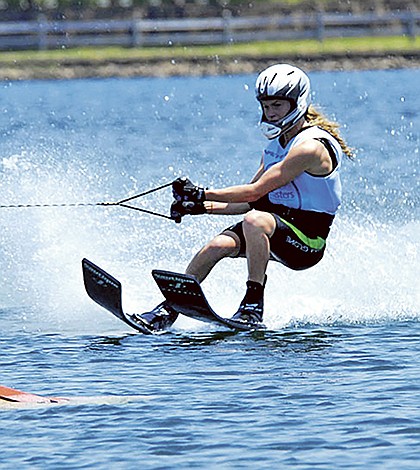- April 4, 2025
-
-
Loading

Loading

While winter was setting in on the Northern Hemisphere Jan. 8, 75 athletes from 21 countries traveled to Lima, Peru, for the biennial four-day 15th Junior Water Ski World Championships.
The individual overall gold medalists both hail from West Orange County: Taylor Garcia, of Winter Garden, won boys’ overall with a score of 2,677.87, and Brooke Baldwin, of Windermere, won girls’ overall at 2,622.35.
USA Water Ski officials dubbed them Male Athlete of the Month and Female Athlete of the Month, respectively, and named the U.S. Junior Water Ski Team its January Team of the Month. All were eligible for the U.S. Olympic Committee’s monthly awards, as well.
Taylor is an 11th-grade home-schooled student who also won the gold in jumping. Brooke is an eighth-grader at SunRidge Middle School and won the silver medal in slalom and the bronze in tricks.
Brooke was also USA Water Ski Rising Superstar of 2014 and on the USA World Junior Team, which won the team championship at the event and won USA Water Ski Team of the Month. Also on that team was Anna Gay, of Winter Garden — a ninth-grader at The First Academy who won the tricks title with a score of 8,470 — and Brooke’s mother, Brenda, the team’s coach.
In the overall classification, there are three events, Brooke said.
“There’s trick, which you do on one ski; slalom, with one long ski (measuring) 64 inches; and jumping, in which you go over a ramp with two skis,” she said.
Her favorites are trick and slalom, because she is better at those two, which are not as scary as jumping, she said.
“(In) tricking, you get two passes, each 20 seconds,” she said. “My flips are very accurate with good technique and efficiency. I have good balance, and I’m fast. I get a lot more tricks in in the same amount of time. Tricking is fun because it’s a lot of flipping, twisting and stuff. Slalom is speed and rhythm.”
Jumping is most dangerous because it involves flying off a ramp about 120 feet, Brooke said, similar to the death-defying snow-ski jump event.
“You can easily drop a ski or catch a tip,” she said. “Common injuries are torn ACLs and stuff like that. Water-skiing injuries are pretty common. Don’t ask why we still do it — the thrill of flight, I guess.”
Relative to snow-skiing, water-skiing might be slightly safer, especially for someone who does it every day, but it depends on skill level, ability, technique, coaching and proper equipment, Brooke said.
“In the school year, I’ll ski two to three times a day, and then summer is three to four minimum,” she said. “Tricks sessions last an hour or an hour-and-a-half. Slalom sets last 20 minutes. Jump sets are 15 minutes. I live on Lake Roper, so I train and ski there, which is the lake by the Winter Garden Cemetery. I also train sometimes on Lake Butler.”
Now in Utah for snow-skiing — on vacation and just for fun, not competitive — Brooke finds the transition natural, because she is accustomed to wearing skis and using them in similar motions, she said.
“Edge control is similar, also,” she said. “Water-skiing to snow-skiing is like wakeboarding to snowboarding. Water-skiing is side-to-side control, and then wakeboarding is front to back, heel-toe.”
Like many peers, Brooke wants to set world records and win professional world championships someday, and she is looking forward to May for the Masters Water Ski and Wakeboard Tournament at Callaway Gardens in Pine Mountain, Georgia, she said.
Neilly Ross, a Winter Garden resident and eighth-grader at Bridgewater Middle School, won silver in tricks at the competition and was a member of Team Canada, which won silver.
Contact Zak Kerr at zkerr@wotimes.com.